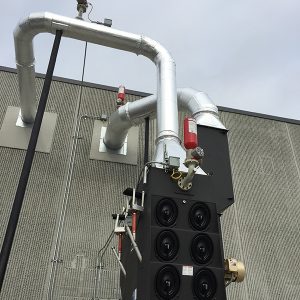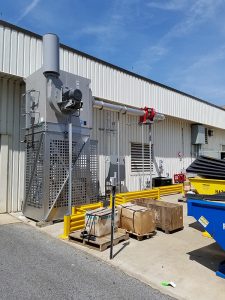
Implementing an explosion protection system is a task which elicits a myriad of questions. SysTech, along with IEP Technologies, has implemented, and installed explosion prevention and protection systems on industrial dust collection processes and are frequently asked questions or need to address statements made by clients. Systems can be as simple as a single explosion vent or an explosion suppression system for critical protection applications. Where applicable we reference the National Fire Protection Association (NFPA), as they have been at the forefront of establishing Explosion Protection Standards. The Standards are frequently adopted by plant health and safety officials, municipalities and insurance companies as rules to follow for compliance. Our questions and answers below are in summary form, and more detailed explanations are available upon request. We’ve listed them as follows, not by importance but by the frequency we are called upon to respond:
- “ARE ISOLATION FLAP VALVES NECESSARY, THEY’RE JUST CHECK VALVES?” – Isolation valves are meant to prevent a secondary explosion by blocking the pressure wave and fire ball, stopping propagation through the air material separator dirty inlet lines. Implementing a backdraft damper, an abort gate or spark arrestor instead of implementing an NFPA compliant explosion isolation valve creates a Standard violation. Isolation valves need to meet at a minimum the requirements of NFPA 69-2014, which include continuous dust accumulation monitoring, flap blade locking, and process shut down requirements.
- “DOESN’T A SPARK DETECTION SYSTEM QUALIFY AS EXPLOSION PROTECTION TOO?” – Not the same thing. Implementing a “fire suppression system” such as CO2 in place of an explosion protection system assumes sparks will be removed from the process, and therefore helps to reduce the ignition potential from the process. Fire and explosion are related issues and need to be addressed differently.
- “I’VE INSTALLED AN EXPLOSION VENT ON THE COLLECTOR, AND IT’S OUTSIDE OF THE BUILDING, DOESN’T THIS SATISFY MY EXPLOSION PROTECTION REQUIREMENTS?” – An explosion vent is only a part of a complete explosion protection system. Compliance to meet NFPA Standards 68, 69, 652, and 654 mandates a requirement for isolation of inlet and outlet ducts depending on their location and integration back to the process. All ducts that go back to space must be protection per NFPA 654, Chapter 7 Section 1.2
- “AREN’T ALL ROTARY AIRLOCKS THE SAME?” – Rotary airlocks are installed at the hopper outlet on the dust collector or product receiver and prevent an explosion from exiting out the bottom of the hopper. Most appear robust and structurally capable of preventing the potential flame from propagating, but that’s not always the case. NFPA 69 12.2 states that Rotary Valve Design Criteria 2008 edition (page 69-23) are met as follows: The valve body and rotor have sufficient strength to withstand the maximum anticipated explosion pressure, Pred, valves have at least six vanes on the rotor and are diametrically opposed, bearings are mounted externally and valves cannot be provided with a design clearance less than .0079″ if required, are a few points. In short, make certain it is approved!
- “MY DUST COLLECTION SYTEM IS GRANDFATHERED!” – It’s been in place for 20 years.”
Old systems they believe are grandfathered because they existed before the latest Standard was issued. The answer to this is not clearly stated in the NFPA Standards. But, if a dust hazard analysis (DHA) is performed, the need to address the issue may prove immediate. How safe are your people and the manufacturing facility?
- “MY INSTALLATION SPACE FOR AN EXPLOSION VENT DUCT IS REALLY CROWDED!” – Most plants have space issues and providing a clear discharge for an explosion vent without obstructions by electrical conduits, sprinkler lines, natural gas piping, other equipment, walls, etc. is difficult. NFPA 68 requires that there is a pressure differential of a least 50 lbs. per ft. or 0.35 psi between the vent release pressure and the resistive pressure of the dust collector or vessel. It also points out that explosion vents must be directed to a safe location due to the fireball produced in an event. Remember fireballs can grow to 8 to 10 times the size of the volume of the vessel from which they originated.
- “THE SUPPLIER TOLD ME THEIR SYSTEM WOULD MEET ALL APPLICABLE CODES?” – You are ultimately responsible for your explosion protection system, not the equipment supplier or installing contractor (see NFPA 654). Ask for documentation, warranties, and proof of testing and that your supplier(s) have worked with similar applications and have proper experience with the application.
- “THESE SYSTEMS ARE EXPENSIVE, AND PRICE IS A MAJOR PART OF MY DECISION PROCESS!” – Just because a product is less expensive and claims to be equivalent or is the most expensive and therefore seems to be the best option, doesn’t mean it necessarily is; compare all design features, performance points, materials of construction and accessories with your explosion protection partner to ensure you are meeting the goals of the Dust Hazard Analysis (DHA), Authority Having Jurisdiction (AHJ) and applicable NFPA Standards. Document everything you are being told about your explosion protection system. Get it in writing!
“MY DUST IS VERY COMMON, WHY TEST IT?” – Dust Hazard Analysis (DHA) and a Dust Testing completion date is defined in NFPA 652. Not having a DHA performed or getting your dust tested before proceeding with an explosion protection system may result in improper protection and wasted capital. NFPA 652 does allow historical or published data deemed to be representative of the material and process conditions to be used. This would be a starting point for a new process and material to test is not available. Once the process is running, and there is material available to test, it would be wise to test it and compare it to what the system was based upon to ensure the proposed protection is sufficient.
- “WHO IS THE AUTHORITY HAVING JURISDICTION AND WHY DO I CARE ABOUT THEM?” The NFPA Standards identify what an AHJ is, but Identifying your governing AHJ and involving them in the decision to understand what is required for your plant is important. Whether it is your insurance carrier, ownership, or local code officials or a combination of these experts knowing the AHJ is important. NFPA 652 redefines the AHJ as someone responsible for enforcement. This will help to ensure a streamlined process when applying for all applicable permit requirements and not cause unnecessary downtime for your plant.
That’s our Top 10. There are others, and we will share those with you in the future. The need to be compliant is one thing, but the most important thing is protecting your people and your facility. Properly applied NFPA guidelines are meant to do just that.
With our applied knowledge of NFPA Standards, SysTech can help navigate the rules to ensure you’re in compliance. Just call us at 800-456-9460 and we can make sense of it all.

 “MY DUST IS VERY COMMON, WHY TEST IT?” –
“MY DUST IS VERY COMMON, WHY TEST IT?” – 
